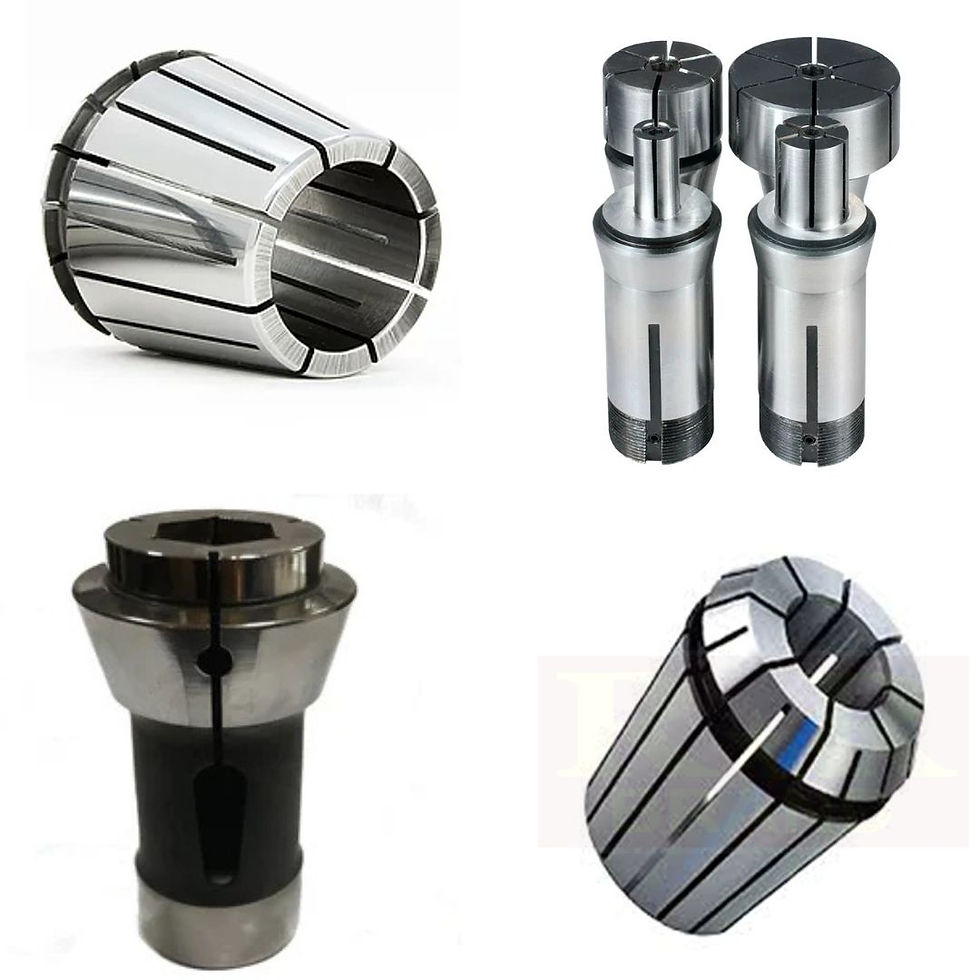Choosing Collets for High-Speed Milling vs Heavy-Duty Turning
- nazmakhatoon1057
- Sep 1
- 3 min read
Selecting the right collet or tool holder is critical for CNC machining performance. The choice affects not only tool life but also precision, surface finish, and spindle longevity. High-speed milling and heavy-duty turning demand different characteristics in tool holders, and understanding these requirements ensures optimal results. This guide will explore the differences, benefits, and applications of collet holders versus milling holders.

What Are Tool Holders in CNC Machining?
A tool holder secures the cutting tool to the CNC spindle, ensuring stability during operations such as milling, drilling, or turning. A well-chosen tool holder can improve accuracy, reduce vibration, and extend tool life, while a poorly selected holder may cause chatter, premature wear, or tool breakage.
Understanding Milling Holders
What Is a Milling Holder?
Milling holders use a needle-bearing mechanism to deform the tool shank, providing high clamping force and rigidity. They are designed to withstand heavy cutting loads and high spindle speeds. Key components include:
Taper: Connects the holder to the spindle, ensuring torque transmission and reducing vibration.
Flange: Provides stability and rigidity during milling operations.
Collet Pocket: Aligns the tool accurately within the holder.
Types of Milling Holders
Weldon Holders: Feature a flat on the shank tightened with a screw, preventing tool pull-out during heavy milling.
Side Lock Holders: Use side screws for precise alignment and higher repeatability.
Shell Mill Holders: Hold larger cutters with increased rigidity for better performance.
Advantages of Milling Holders
High grip strength due to needle roller deformation
Reduced vibrations and chatter
Extended tool life through enhanced stability
Disadvantages
Limited to flat shank tools
Higher runout compared to collet holders
Costlier than collet systems
For heavy metals and demanding applications, explore heavy-duty collets for turning machines for compatible options.
Understanding Collet Holders
What Is a Collet Holder?
Collet holders secure tools inside a conical collet, distributing clamping force evenly. This design ensures low runout, high precision, and superior repeatability. The main components include:
Collet: Round, slotted pieces that contract and expand to grip the tool.
Nut: Tightens the collet and secures the tool in place.
Collet Pocket: Aligns the holder precisely for minimal deviation.
Types of Collet Holders
ER Collet Holder: Flexible and versatile, ideal for light milling and finishing. ER collets for milling machines offer low runout and high repeatability.
Micro Holder: Designed for small-diameter tools requiring extreme precision.
Super Holder: High gripping force with excellent runout control for high-speed spindles.
Advantages of Collet Holders
Low runout for high-speed machining
Versatile for multiple tool diameters
Quick tool changes increase productivity
Affordable and flexible solution
Disadvantages
Lower grip strength than milling holders in heavy-duty applications
Less effective for extremely hard or thick workpieces
Key Differences Between Milling and Collet Holders
Feature | Milling Holder | Collet Holder |
Grip Strength | Higher due to needle roller mechanism | Moderate; friction-based |
Runout | Moderate | Very low; uniform clamping |
Balance | Good | Excellent |
Versatility | Limited; specific to shank sizes | High; multiple diameters supported |
Cost | Expensive | Affordable |
Which Holder Is Best for Heavy-Duty Turning?
For heavy metals like stainless steel or titanium, milling holders are preferred. They offer superior rigidity, can handle high radial and axial loads, and maintain balance at spindle speeds up to 12,000 RPM. The enhanced stability reduces vibration, protects the spindle, and extends the life of cutting tools.
Which Holder Works Best for High-Speed Milling?
For soft metals like aluminum and operations requiring precision finishing, collet holders are ideal. The even clamping force minimizes runout, ensures consistent cutting, and supports high-speed spindles. Consider exploring precision ER collet sets for achieving optimal results.
Maintenance Tips for Both Holders
Proper maintenance is essential to prolong tool life:
Remove chips and debris after each operation
Lubricate tool holders lightly during storage
Keep collet components dry and clean
Avoid over-tightening to prevent tool or holder damage
Inspect tool holders regularly for wear or deformation
For more guidance, check this complete collet and chuck guide.
Conclusion
Choosing the right holder depends on your material, spindle speed, and machining requirements. Milling holders excel in heavy-duty turning and rigid operations, while collet holders shine in high-speed milling and precision finishing.
Implementing the correct holder, combined with proper setup and maintenance, ensures higher productivity, extended tool life, and superior machining results.

Comments